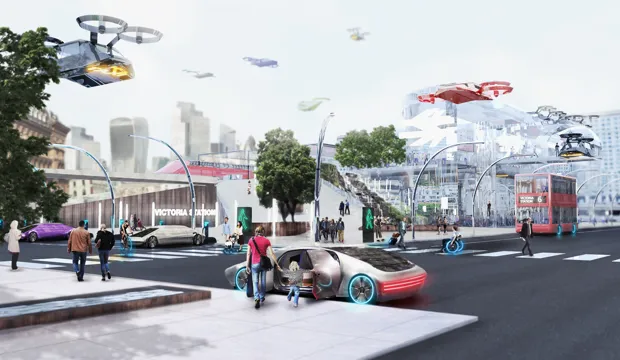
Roads and highways FCD
IET Faraday® DIY Challenge Day with Rees Jeffrey Road Fund and National Highways.
A set of printable resources and guidance notes giving teachers and technicians the basic ingredients to run their very own IET Faraday® Challenge Day. This cross-curricular activity day brings science, design and technology, engineering and maths together in an engaging way.
The context of the challenge
William Rees Jeffreys was born in London in 1871 in a world very different to the one we now know. During his lifetime, the numbers of people travelling more often and further afield greatly increased and has continued to increase to this day.
This increase has brought with it new challenges. Rees Jeffreys’ vision was to create better, more attractive, safer and more accessible roads for us all.
He was also a keen cyclist and an advocate for safe road design, believing that roads were an amenity, opening up access to the countryside for recreation and the appreciation of beauty as well as providing connections between villages, towns and cities. The charity set up in his name continues to influence our roads and road design, even to this day.
National Highways is responsible for operating, maintaining and improving the strategic road network which is the 4,500 miles of motorways and major A roads in England. Our work is broad and includes such things as providing real-time traffic information to drivers, traffic officers responding to incidents and delivering improvement schemes, helping customers have safer, smoother and more reliable journeys. Like Rees Jeffreys’ early pioneering work, our focus is on making people’s lives easier and better and the projects we fund reflect this.
These two formidable influences on our road network, the Rees Jeffreys Road Fund and National Highways have come together and partnered with the IET for this IET Faraday Challenge.
Since Rees Jeffreys time, our highways have developed beyond recognition. He would be amazed at the 33 million passenger cars on our roads today compared to the 3.3 million in the 1950s. It is true that cars and travel have become safer and electric cars are beginning to reduce the impact of pollution around our roads. But we still have far to go in ensuring all those who travel around our community can do so safely and with ease.
But these are exciting times, presenting great opportunities for us to rethink our environments. William Rees Jeffreys felt roads should be enjoyed and that the aesthetics of them, and the views from them, should be celebrated. The strapline of the Rees Jeffreys Road Fund, ‘Roads really matter to all of us’, encapsulates this. So how do we use current and future developments to ensure that we meet the needs of all users?
The brief for this challenge is very broad and it is up to you and your team to decide where you want to focus your engineering skills. Do you want to think about your local community or is your priority to consider those using our major road and motorway network?
So, engineers, your brief is to decide on one area, which you feel is a priority for your team, and design and build a prototype to improve the experience of our road users. This could be an idea which supports any one group or even all groups of road users, from cyclists to transport companies, or it could support the workers who will have to construct and maintain your product in the real world.
You will need to be innovative. Remember, your idea could become part of our future.
You must also consider all the following in your design:
- Social value. Putting people at the heart of everything is critical so, if it doesn’t benefit people, the environment or the economy it’s not worth developing.
- Safety. This is central to any idea for both road users and those who construct our highways.
- Sustainability. National Highways has a target of being net zero carbon by 2050 so your idea must contribute to this.
- And access and inclusion. Bringing equity for all users of our roads and services. You should design for access and inclusion from the outset.
We are excited about your contribution to our future and we can’t wait to see your ideas.
Good luck engineers!
Activity info and teachers’ notes
The Rees Jeffreys Road Fund and National Highways challenge is based on the IET Faraday® Challenge of the same name from our 2023/24 season of IET Faraday® Challenge Days.
Students are given an engineering brief (found in the student booklet) to help design a prototype to improve the experience of our road users. They will need to demonstrate that they have the engineering skills required to engineer and construct a working prototype of their design and pitch their products to the judges.
Designed for six teams of six students (36 students in total) aged 12-13 years (year 8 England, and equivalent), the challenge encourages the development of students’ problem solving, team working and communication skills.
This activity day can be tailored to the needs of your school and your students by adapting the PowerPoint presentation and the student booklet.
What’s included?
The complete set of downloadable materials includes:
- Teachers’ pack - A list of the practical materials needed, presenters’ notes highlighting key areas and reinforcing key themes throughout the day, some handy hints on how to deliver the day . . . plus printable Faradays currency and student certificates.
- Student booklet - Available as an editable MSWord document to allow the booklet to be adapted to meets the needs of your students and your school.
- PowerPoint presentation - A step-by-step guide for your students throughout the day, with supporting notes for the delivery of the presentation.
- Film clip - Full briefing video introducing the challenge to your students.
Extension
For those students who have excelled at this challenge and are looking for a little more, why not download our extension activity and see how far their engineering skills can take them?
Remember, it’s all free!
All online resources (including film clips!) are free to download, and the student booklet and PowerPoint presentation are fully editable, so you can tailor them to your students’ and your schools’ needs.
You can stream and download the related film for free by clicking on the appropriate link in the video section below.
Available Downloads

Delivery guide
Activity description, delivery notes and curriculum links.

Student booklet
Information for Students to use during the challenge day

Planning and events log
Give to each team to record designs and events throughout the day

Presentation
PowerPoint slideshow outlining the challenge brief

'How to' sheets
How to sheets for give ideas and practical instructions

Helpful documents for the challenge day including currency, shop documentation and resource pricelist, and team account sheets, registration forms and certificates.

Extension activity
Additional activity to stretch students knowledge further.

Extension activity map
Map of area used in the extension activity


